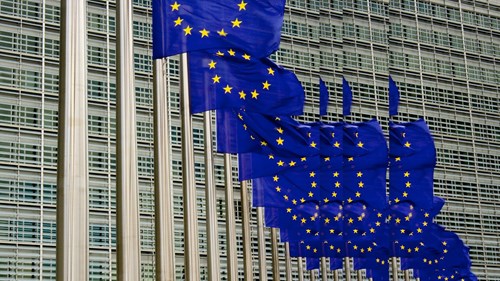The gloves are off: EU responds to US tariff challenge with timed precision
After appearing initially restrained, the EU has chosen its moment to respond decisively to US President Trump's renewed 25% tariffs on steel and aluminum.
On February 10, 2025, US President Trump reinstated Section 232 tariffs, imposing a 25% duty on all steel and aluminum products imported into the US. In response, on March 12, 2025 – the day these US tariffs came into force – the EU Commission unveiled a set of countermeasures. First, it plans to reinstate tariffs on certain US exports, such as Harley-Davidson motorcycles and Kentucky bourbon, originally imposed in 2018 and suspended in 2021, effective April 1, 2025. Additionally, the EU Commission intends to introduce further countermeasures by mid-April, potentially targeting American agricultural products and technology goods. These two measures aim to target various US products, aiming to mitigate an anticipated €26 billion in economic harm from the US tariffs on EU steel and aluminum. This announcement comes two days after EU Trade Commissioner Maroš Šefčovič told reporters that the US administration was unwilling to negotiate an agreement to prevent the imminent trade conflict between the US and EU.
I. Tariffs under US Law
The US tariffs imposed by US President Trump on February, 10 2025 are based on Section 232 of the Trade Expansion Act of 1962 (19 US Code § 1862). Section 232 allows the US President to impose import restrictions based on a determination by the Department of Commerce that certain imports threaten US national security. However, what constitutes a threat to US national security is ambiguous. Traditionally, the Department of Commerce has understood the term to refer to three categories of national security requirements: direct defence (i.e., weapons production), indirect defence (i.e., supplies needed for the weapons production) and civilian demand (i.e., supplies to protect the civilian population in times of emergency). Recently, however, the assessment of the Department of Commerce focused on economic considerations more broadly. While such economic considerations are also mentioned in Section 232, the provision expressly links them to the question “whether such weakening of our internal economy may impair the national security”.
US President Trump had already relied on Section 232 during his first term in Office to impose tariffs on steel and aluminum products. In 2017, he directed then-Commerce Secretary Wilbur Ross to conduct an investigation into the impact of steel and aluminum imports on US national security. In February 2018, the Department of Commerce concluded that imports of steel and aluminum products threatened US national security. Based on this report, in March 2018, US President Trump imposed tariffs of 25% on steel and 10% on aluminum imports.
II. EU’s countermeasures under the Enforcement Regulation
In June 2018, the EU retaliated by imposing tariffs on a wide range of US goods, including steel and aluminum as well as some emblematic US consumer goods such as bourbon whiskey, Harley Davidson motorcycles and blue jeans (so-called Annex I measures). The EU added further measures in 2020 (so-called Annex II measures). Before the Annex II measures came into effect, the US and EU agreed to suspend their respective tariffs in exchange for a tariff quota system limiting exports of steel and aluminum products.
In response to US President Trump’s new imposition of tariffs on the EU, the EU Commission now announced that it will allow the Annex I and Annex II measures to come into force on 1 April 2025. Additionally, the EU Commission announced further countermeasures which will target approximately €18 billion worth of goods. The EU Commission also announced that it will base these additional measures on Regulation (EU) No 654/2014 (the “Enforcement Regulation”). The Enforcement Regulation lays down rules and procedures to suspend concessions or other obligations under international trade agreements, with the intention of responding to breaches by third countries of international trade rules (Art. 1(a) Enforcement Regulation) or rebalancing concessions or other obligations in trade relations with third countries, when the treatment accorded to goods from the EU is altered in a way that negatively affects the EU’s interests (Art. 1(b) Enforcement Regulation). To this end, Art. 5(a) of the Enforcement Regulation allows for the suspension of tariff concessions and the imposition of new or increased customs duties.
The EU Commission considers the reimposition of US tariffs by US President Trump to be a safeguard measure within the meaning of Art. 8 of the WTO Agreement on Safeguards. This assessment allows the application of the Enforcement Regulation pursuant to its Art. 3(c). However, there are certain doubts regarding the EU Commission’s assessment. In the proceedings between China, Norway, Switzerland and Turkey against the US in the case “United States — Certain Measures on Steel and Aluminium Products”, the WTO panel found that the US tariffs did not qualify as safeguard measures as they were motivated by US national security interests. The panel report was appealed into the void and the EU was not a party to the dispute, therefore, open questions remain. Alternatively, the EU could invoke Art. 3(d) of the Enforcement Regulation which applies in cases of non-compensated modification of concessions or commitments by a WTO member under Article XXVIII of the GATT 1994 (see on this here).
As part of the process to implement these additional measures, the EU Commission has launched a two-week consultation with EU stakeholders. The aim of the consultation is to identify the appropriate products for inclusion in the new measures and to ensure an effective and proportionate response in line with the criteria listed in Art. 4(3) of the Enforcement Regulation. Anyone who is affected by the US tariffs or may be affected by the new EU measures may submit their views by replying to the EU Survey by March, 26 2025, 12:00 Brussels time.
III. Looking ahead: What other options does the EU have?
In addition to the measures announced under the Enforcement Regulation, the EU Commission could invoke Regulation (EU) 2023/2675 (the “Anti-Coercion-Instrument” or “ACI”). The ACI, which came into force in 2023, allows the EU to take retaliatory measures against third countries that use economic coercion against the EU or one of its Member States to induce, to prevent or obtain the cessation, modification or adoption of a particular legal act (Art. 2 ACI). The ACI allows the EU adopt further measures besides the imposition of tariffs, including measures relating to transiting goods, measures affecting the supply of services and access by foreign investors to the EU, measures restricting protection of IP rights and their exploitation, measures restricting the right of third country companies to participate in public procurement tender procedure as well as measures restricting access by banking and insurance entities to EU capital markets and other financial services activities. Particularly measures targeting the trade in services could significantly affect the US, which has a large surplus in trade of services to the EU, particularly digital services.
The EU may also decide to challenge the US tariffs before the WTO. The EU filed already a complaint against the steel and aluminum tariffs introduced by US President Trump in 2018, but agreed with the Biden administration on a negotiated solution in 2021. While the EU could obtain a favourable panel report under the WTO Dispute Settlement Understanding (“DSU”), there are significant drawbacks to this approach: Such a procedure is very time-consuming and would take several months or even years. More importantly, given the dysfunction of the WTO’s Appellate Body, the US could simply appeal “into the void” under Art. 17 DSU, which would leave a final decision pending.
Going beyond trade measures, the EU could also decide to target large US tech firms using the EU’s Digital Services Act and Digital Markets Acts. Investigations are already ongoing against Apple, Meta and others which may result in fines of up to 10% of the company’s total worldwide annual turnover, or up to 20% in the event of repeated infringements.
IV. Deal-Making always appears to be on the table with US President Trump
A renewed trade conflict between the US and EU would inevitably harm both sides, making negotiation the prudent path forward. The EU is focused on maintaining robust transatlantic economic ties and avoiding further escalation. In this spirit, EU Commission President Ursula von der Leyen emphasized on March 12, 2025, that the EU is eager for meaningful negotiations and stands ready to reverse its countermeasures if a diplomatic solution can be reached. Given that US President Trump is well-known for his deal-making acumen, there appears to be a persistent opportunity for constructive dialogue. Potential negotiation points could include the reduction of EU tariffs on industrial goods, such as automobiles – currently at 10% compared to 2.5% in the US – and the prospect of increased US military procurement from the EU's proposed significantly expanded defence budget. The coming weeks are crucial in determining whether this dispute devolves into a full-blown trade war or fosters a new diplomatic understanding. For businesses, staying informed on EU trade policy, assessing supply chain vulnerabilities, and preparing for regulatory adjustments are imperative in this evolving landscape.
We would like to thank Christoph Priess for contributing to this publication.






